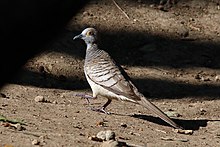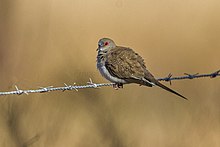Indo-Australian small pigeons
| Indo-Australian small pigeons | ||||||||||
|---|---|---|---|---|---|---|---|---|---|---|

Copper-necked pigeon ( Geopelia humeralis ) |
||||||||||
| Systematics | ||||||||||
|
||||||||||
| Scientific name | ||||||||||
| Geopelia | ||||||||||
| Swainson , 1837 |




The Indo-Australian small pigeons ( Geopelia ) are a genus of the pigeon birds (Columbidae). The genus includes five species that are native to Southeast Asia and Australia. All five species are often kept as ornamental birds.
Appearance
Indo-Australian pigeons are small species of pigeons. The largest among them is the copper-necked pigeon , which reaches a body length between 28 and 31 centimeters. The diamond pigeon as the smallest species of the Indo-Australian small pigeons is about as big as a lark with a body length of 19.5 centimeters.
The pointed outermost hand swing arm is characteristic of all five species. With the exception of the diamond pigeon, all other species have plumage on the upper side of the body with dark borders, so that a fine sparrow-hawking results. The underside of the body is without further markings.
Distribution area and habitat
The distribution area of the Indo-Australian small pigeons extends from the Malacca peninsula over the Great Sunda Islands and New Guinea to Australia. They are absent there in the southwest of mainland Australia as well as on Tasmania . The pigeon was also introduced to Hawaii and is now one of the most common birds there.
Diamond pigeons and hawk pigeons inhabit open land covered with trees or bushes. The peace dove occurs in sparse savannah forests and also inhabits steppes. The copper-necked pigeon is a species that inhabits gallery forests along the course of rivers as well as wooded areas near the water. Dense mangrove forests are also part of their habitat .
Keeping in human care
All Indo-Australian small pigeons were imported to Europe between 1840 and 1868. The first offspring in human care followed shortly afterwards. The small diamond dove is very popular as an ornamental bird. It is considered to be easy to keep, easy to breed and peaceful. With the exception of the copper-necked pigeon, all species must be wintered warm.
species
The following species are counted among the Indo-Australian small pigeons:
- Diamond dove , also called diamond dove ( Geopelia cuneata )
- Copper-necked pigeon ( Geopelia humeralis )
- Timor pigeon ( Geopelia maugeus )
- Peace dove ( Geopelia placida )
- Hawk pigeon , also known as the hawk pigeon ( Geopelia striata )
literature
- Bruce M. Beehler , Thane K. Pratt: Birds of New Guinea; Distribution, Taxonomy, and Systematics . Princeton University Press, Princeton 2016, ISBN 978-0-691-16424-3 .
- David Gibbs, Eustace Barnes, John Cox: Pigeons and Doves - A Guide to the Pigeons and Doves of the World. Pica Press, Sussex 2001, ISBN 90-74345-26-3 .
- Alois Münst, Josef Wolters: Pigeons - The types of wild pigeons. 2nd expanded and revised edition, Verlag Karin Wolters, Bottrop 1999, ISBN 3-9801504-9-6 .
- Gerhard Rösler: The wild pigeons of the earth - free living, keeping and breeding. M. & H. Schaper Verlag, Alfeld-Hannover 1996, ISBN 3-7944-0184-0 .
Web links
Individual evidence
- ↑ Gerhard Rösler: The wild pigeons of the earth - free life, keeping and breeding . M. & H. Schaper Verlag, Alfeld-Hannover 1996, ISBN 3-7944-0184-0 , p. 178.
- ↑ Gerhard Rösler: The wild pigeons of the earth - free life, keeping and breeding . M. & H. Schaper Verlag, Alfeld-Hannover 1996, ISBN 3-7944-0184-0 , p. 174.
- ^ Beehler & Pratt: Birds of New Guinea , p. 70.
- ↑ Gerhard Rösler: The wild pigeons of the earth - free life, keeping and breeding . M. & H. Schaper Verlag, Alfeld-Hannover 1996, ISBN 3-7944-0184-0 , pp. 174-178.